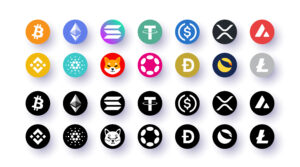Introduction:
In the world of cryptocurrency, the term altcoin refers to any digital currency that is an alternative to Bitcoin. While Bitcoin remains the most well-known and widely adopted cryptocurrency, thousands of altcoins have emerged since its inception in 2009. This article will delve into the intricate world of altcoins, exploring their characteristics, types, advantages, disadvantages, and their role in the broader cryptocurrency ecosystem.
What are Altcoins?
The term altcoin is a blend of “alternative” and “coin.” It encompasses all cryptocurrencies that are not Bitcoin. Altcoins can vary significantly in terms of technology, use cases, and market capitalization. They can be broadly categorized into several types, including:

- Stablecoins: These are pegged to a stable asset, such as a fiat currency like the US dollar. Examples include Tether (USDT) and USD Coin (USDC).
- Utility Tokens: These are designed to provide access to a specific application or service. For instance, Ethereum (ETH) is used to pay for transactions and computational services on the Ethereum network.
- Security Tokens: These represent ownership in an asset or company and are subject to regulatory scrutiny. They are often used in Initial Coin Offerings (ICOs).
- Forks: These are created when a cryptocurrency undergoes a significant change in its protocol, leading to the creation of a new coin. Examples include Bitcoin Cash (BCH) and Ethereum Classic (ETC).
The Rise of Altcoins
The rise of altcoins can be attributed to several factors:
- Innovation: Many altcoins aim to improve upon Bitcoin’s limitations, offering faster transactions, lower fees, or enhanced privacy features.
- Diverse Use Cases: Altcoins are often designed for specific applications, such as smart contracts, decentralized finance (DeFi), or non-fungible tokens (NFTs).
- Investment Opportunities: As the cryptocurrency market has matured, investors have sought alternative assets beyond Bitcoin, leading to the proliferation of altcoins.
Major Categories of Altcoins
1. Stablecoins
Stablecoins are a crucial segment of the altcoin market. Their primary advantage is their stability, making them ideal for transactions and as a store of value. They are often used in trading pairs on exchanges and can help mitigate the volatility associated with other cryptocurrencies.
Popular Stablecoins:
- Tether (USDT): One of the first and most widely used stablecoins, pegged to the US dollar.
- USD Coin (USDC): A fully-backed stablecoin by Circle and Coinbase, also pegged to the US dollar.
- Dai (DAI): A decentralized stablecoin generated by the Maker Protocol, which maintains its peg through smart contracts.
2. Utility Tokens
Utility tokens provide users with access to a product or service within a blockchain ecosystem. They are not intended as investments but rather as a means to facilitate transactions within their respective platforms.
Examples of Utility Tokens:
- Ethereum (ETH): Used to pay for gas fees and transaction costs on the Ethereum network.
- Binance Coin (BNB): Initially launched as a utility token for the Binance exchange, offering discounts on trading fees.
- Chainlink (LINK): Used to pay for services on the Chainlink network, which connects smart contracts with real-world data.
3. Security Tokens
Security tokens represent ownership in a real-world asset, such as stocks or real estate. They are subject to regulatory oversight and must comply with securities laws. This category of altcoins is gaining traction as traditional finance and blockchain technology converge.
Notable Security Tokens:
- Polymath (POLY): A platform that facilitates the creation and management of security tokens.
- tZERO (TZROP): A blockchain-based platform for trading security tokens.
4. Forks
Forks occur when a cryptocurrency’s code is modified, resulting in the creation of a new coin. Forks can be categorized into hard forks and soft forks, with hard forks resulting in a permanent divergence from the original blockchain.
Famous Forks:
- Bitcoin Cash (BCH): Created from a hard fork of Bitcoin to increase transaction capacity.
- Ethereum Classic (ETC): Emerged after a hard fork of Ethereum following the DAO hack.
Advantages of Altcoins
Altcoins offer several advantages over Bitcoin:
- Diverse Investment Opportunities: With thousands of altcoins available, investors have a broader range of options to diversify their portfolios.
- Innovation and Technology: Many altcoins introduce new technologies and solutions that can address specific challenges within the cryptocurrency space.
- Lower Entry Barriers: Altcoins often have lower prices than Bitcoin, making them more accessible for new investors.
Disadvantages of Altcoins
Despite their advantages, altcoins also come with risks:
- Volatility: Many altcoins are subject to extreme price volatility, making them risky investments.
- Lack of Regulation: The altcoin market is less regulated than traditional financial markets, leading to potential fraud and scams.
- Limited Adoption: While some altcoins gain popularity, many remain obscure and may not achieve widespread use.
The Role of Altcoins in Cryptocurrency Ecosystem
Altcoins play a vital role in the cryptocurrency ecosystem by introducing new technologies and use cases. They contribute to the overall growth and development of the blockchain space, fostering competition and innovation.
Decentralized Finance (DeFi)
One of the most significant trends in the cryptocurrency space is the rise of decentralized finance (DeFi), which aims to recreate traditional financial systems using blockchain technology. Many DeFi projects rely on altcoins to function, offering services such as lending, borrowing, and trading without intermediaries.

Non-Fungible Tokens (NFTs)
Another area where altcoins have made a significant impact is in the realm of non-fungible tokens (NFTs). NFTs are unique digital assets that represent ownership of a specific item, such as art, music, or collectibles. Many NFT platforms utilize altcoins for transactions, further expanding their use cases.
Interoperability and Cross-Chain Solutions
As the cryptocurrency ecosystem continues to grow, the need for interoperability between different blockchains has become increasingly important. Altcoins are often designed to facilitate cross-chain transactions and interactions, allowing users to move assets seamlessly across various platforms.
Conclusion
In conclusion, altcoins are a diverse and dynamic segment of the cryptocurrency market. They offer unique advantages and opportunities for investors and users alike. As the cryptocurrency ecosystem continues to evolve, altcoins will play a pivotal role in shaping the future of finance and technology. Understanding the various types of altcoins, their benefits, and their challenges is essential for anyone looking to navigate the exciting world of digital currencies.


Pingback: Cryptocurrency Wallets: A Comprehensive Guide - Info Spher Hub